Case study: Andmind Group [Activity Theory]
![Case study: Andmind Group [Activity Theory]](https://images.unsplash.com/photo-1620662831351-9f68f76d0b9a?crop=entropy&cs=tinysrgb&fit=max&fm=jpg&ixid=MnwxMTc3M3wwfDF8c2VhcmNofDI4fHx0aGlua3xlbnwwfHx8fDE2MzQxNjA0Mzg&ixlib=rb-1.2.1&q=80&w=960)
Typology is a great tool for learning and using theories. We can consider typology as a type of intermediate knowledge for connecting theoretical research and domain practice. As an information architect, I create typologies for curating data and information and designing websites and apps. I also collect typologies for learning new knowledge.
Spinuzzi’s Typology of Activities
In 2014, I started learning Activity Theory. After reading some books and papers about Activity Theory, I moved to search for some typologies of activities. In 2015, I found Clay Spinuzzi’s paper Toward a Typology of Activities: Understanding Internal Contradictions in Multiperspectival Activities. He pointed out, “AT (Activity Theory) currently lacks a suitable typology for characterizing ideal types of activities in terms of multiperspectivity, so it has had trouble systematically characterizing the resulting sets of internal contradictions.”
Spinuzzi came to the conclusion that there is a need to make an ideal typology of activities for general purpose to “explore internal contradictions resulting from hybrid activities”.
Spinuzzi said, “To develop an adequate typology of activities, then, we must characterize these objects — keeping in mind that since objects are multiperspectival, specific activities will often appear as hybrids located within this typology rather than fit neatly into a given type.”
He proposed a new matrix with the following two dimensions:
- How is the object defined? Is it defined explicitly and deductively or tacitly and inductively?
- Where is the object defined? Is it defined within the activity’s division of labor or outside it?
The outcome is a matrix with four quadrants (see the diagram below) which represent four ideal activity types.
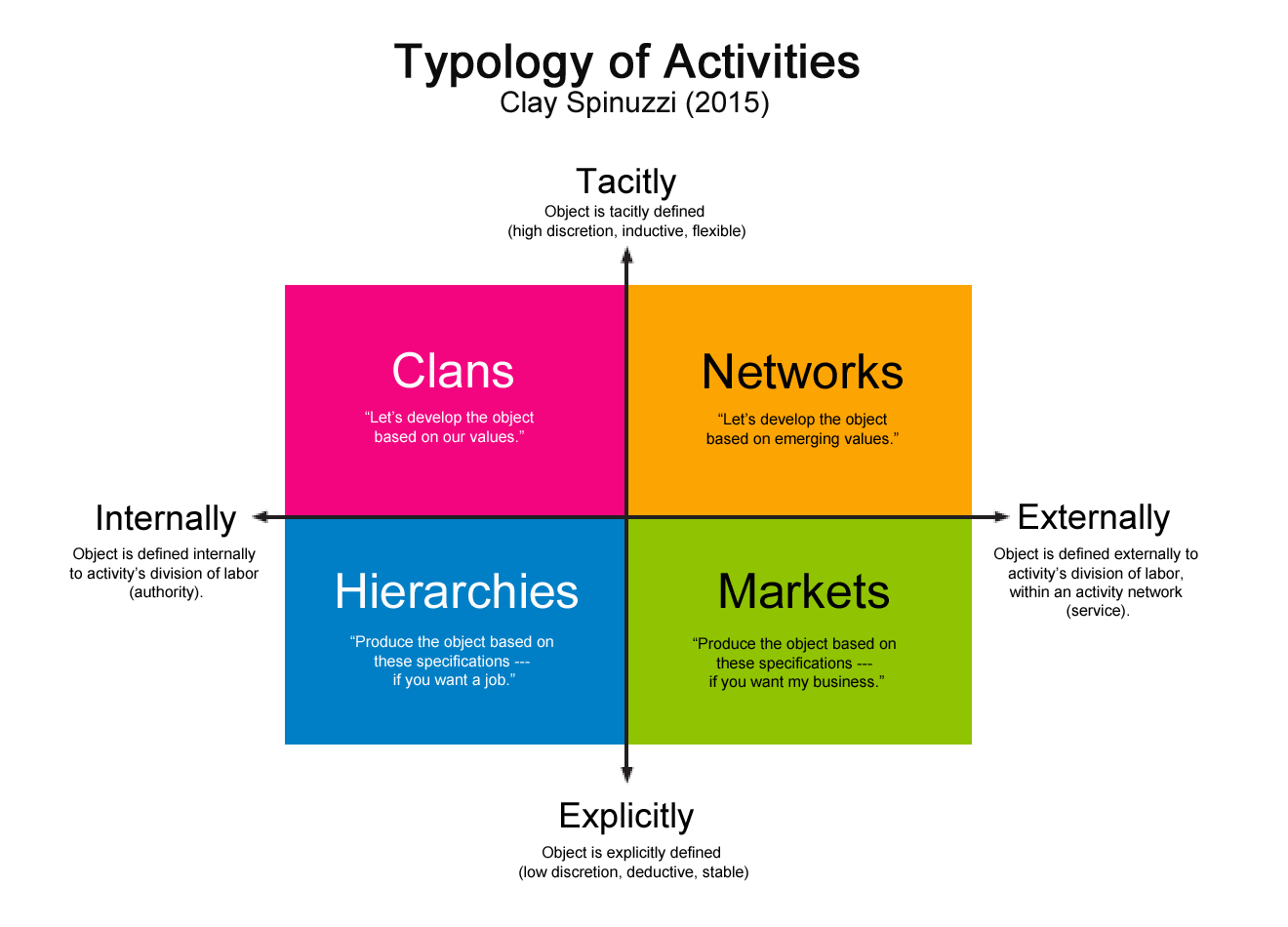
Spinuzzi named these four ideal types of activities as Hierarchies, Markets, Clans, and Networks. We have to notice these words are just names of ideal types. Spinuzzi said, “I use the term markets in the sense of most organizational typologies (e.g.,Adler & Heckscher, 2007; Boisot & Child, 1999; Boisot et al., 2001; Cameron & Quinn, 2011; Ouchi, 1980; Ronfeldt, 2007), not strictly in the sense of commerce. Clan may be too precise; I prefer Adler and Heckscher’s (2007) ‘community.’ But the term community already denotes a different concept in activity theory.”
I really like Spinuzzi’s typology of activities and applied it to a strategy development discussion in 2017. I’d like to share this experience as a story for case study.
The background
The hero of the story is Mr. Seldon who names his enterprise as Andmind Group.
Mr. Seldon is an ambitious serial entrepreneur with a unique educational background of psychological science. In 2015, Mr. Seldon moved to the educational field and started his third business: Andmind Group. Mr. Seldon didn’t use “Andmind Group” as a name for his business. I just use this term to refer to various activities of his new enterprise.
An interesting theme of this story is personal enterprise which goes beyond the narrow narrative of business startup. Thus, I will use Andmind Company to refer to his business and Andmind Group to refer to the whole scope of his business activities and related personal activities.
The situation
In 2014, Andmind Group started as a social media group with about 250 members. In 2015, Mr. Seldon registered Andmind Company as a business entity and started formal daily operation. By 2017, the enterprise of Andmind Group expanded to various activities (see the diagram below).
- Seldon’s Club: a mentor-mentee kind of group with about 25 members.
- Andmind Collection: a publishing program which focuses on “the third culture”.
- Andmind Social Media Group: a social network app based cross-disciplinary elite group. About 250 members including 100 PhDs.
- Andmind Conference: an annual offline event program.
- Andmind Company: a registered business entity with about 9 employees. For the diagram below, I use “Andmind Company” to refer to the activity of their work team.
- Andmind Tribe: a social learning program provided by Andmind Company. About 300 paid learners.
- Andmind App: a mobile app developed by Andmind Company.
- Andmind Academy: a business brand name of Andmind Company. In 2015, the brand name was Andmind Media Communication. Why did I consider it as an activity? Because the company used it to host social media marketing activities.
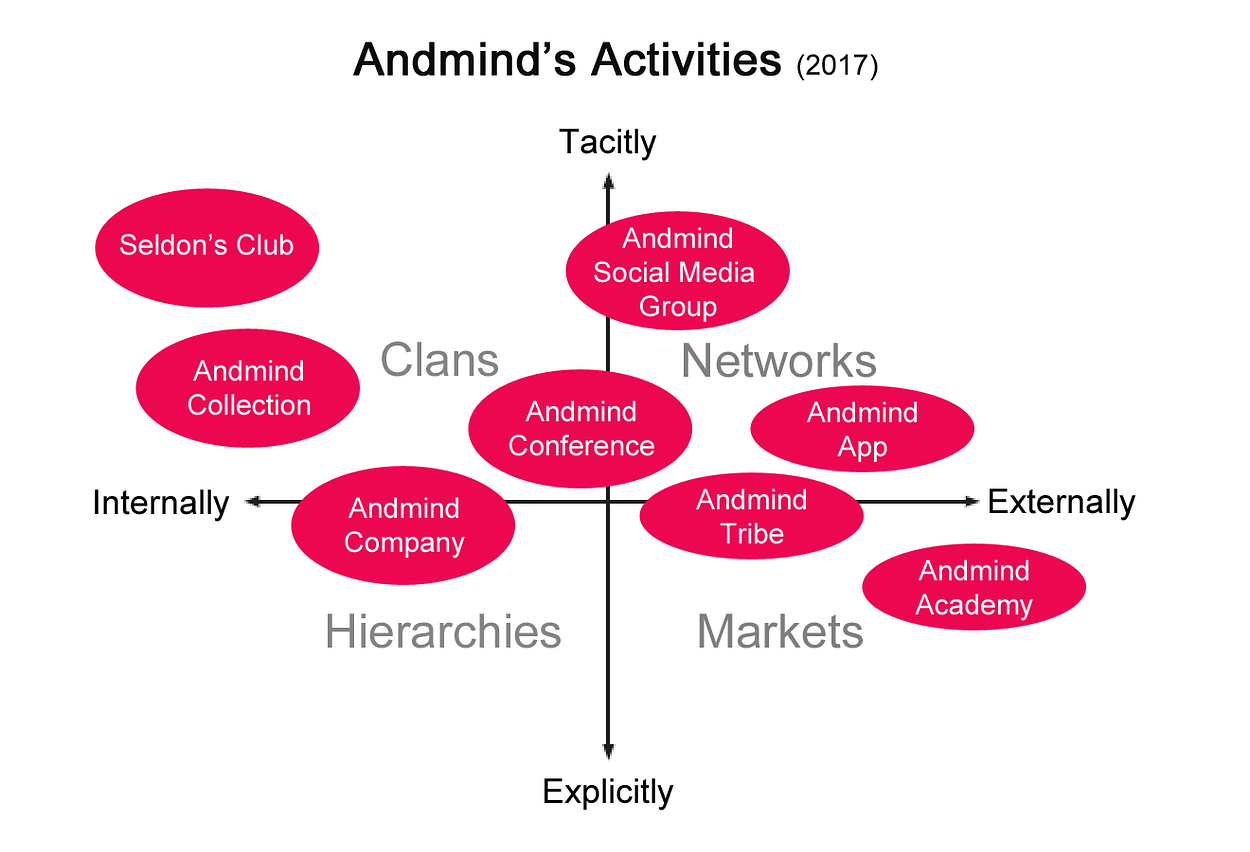
I was deeply involved in Mr. Seldon’s enterprise. As a reader, I read his blog articles. As a member of Andmind social media group, I was an active participant. As an adviser, I watched the transformation of Andmind Group and gave suggestions to the team. As a friend, I gave support to and gained motivation from the development of his life trajectory and life theme.
What I learned from the case of Andmind Group is the complexity of human activity in collective context. If we consider Andmind Group as a normal business case, it is easy to jump to a conclusion that he should focus on one thing and make it big. However, it is better to see Andmind Group as Mr. Seldon’s personal enterprise, or a vehicle for archiving his life mission.
In order to understand the whole story, we should trace back to his psychobiography (including self-identity). Mr. Seldon is not a normal entrepreneur, he likes reading and writing. The essential activity of his life is embracing “the third culture” by writing scientific articles on his personal blog. His social models are Steven Pinker, James G. March, Richard Dawkins, Vladimir Nabokov, Isaac Asimov, and Paul Graham. If we connect Andmind Group with his personal life theme, then we can understand it is not a simple business.
However, the Andmind Group is not a personal blog. The above diagram represents its various collective activities in which different actors have their own goals. I observed that many contradictions emerged from the development of the Andmind Group.
The strategy
In Sept 2017, I adopted Spinuzzi’s typology of activities to analyze the situation of Andmind Group and hosted a strategic discussion about the potential development directions of the enterprise. During the discussion, I realized the practical value of typology is really impressive.
Since Andmind Group’s activities were widely distributed in four quadrants, I just gave a simple suggestion: Let’s reduce the scope to two quadrants. This heuristic method generated six possible directions: Political Group, Technological Platform, Traditional Business, Communities of Practice, Family Gang, and Social Enterprise.
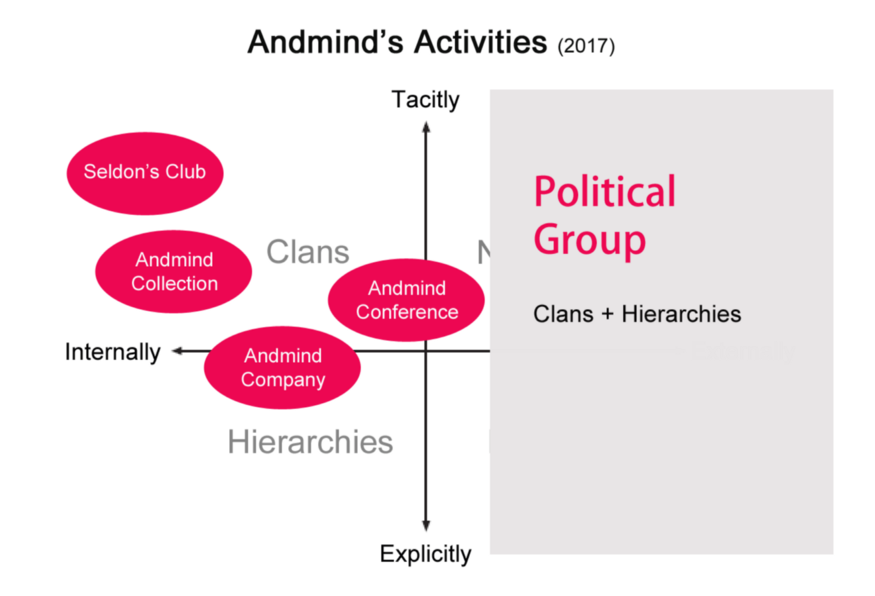
If we cut the Networks and Markets, but keep Clans and Hierarchies. This means we don’t care about business and money, thus the object of running a structured group with internal high trust is clear: change the society. In other words, this is Political Group. We definitely abandon this direction.
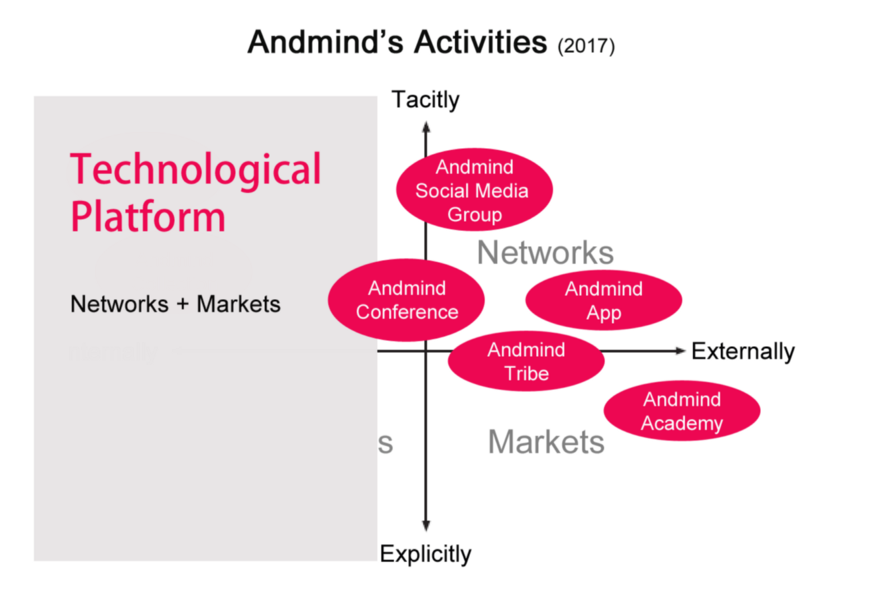
The second direction is keeping networks and markets. For example, we could focus on the Andmind App and expand it to a large scale mobile educational platform. We called this direction Technological Platform. This is also the final solution I suggested.
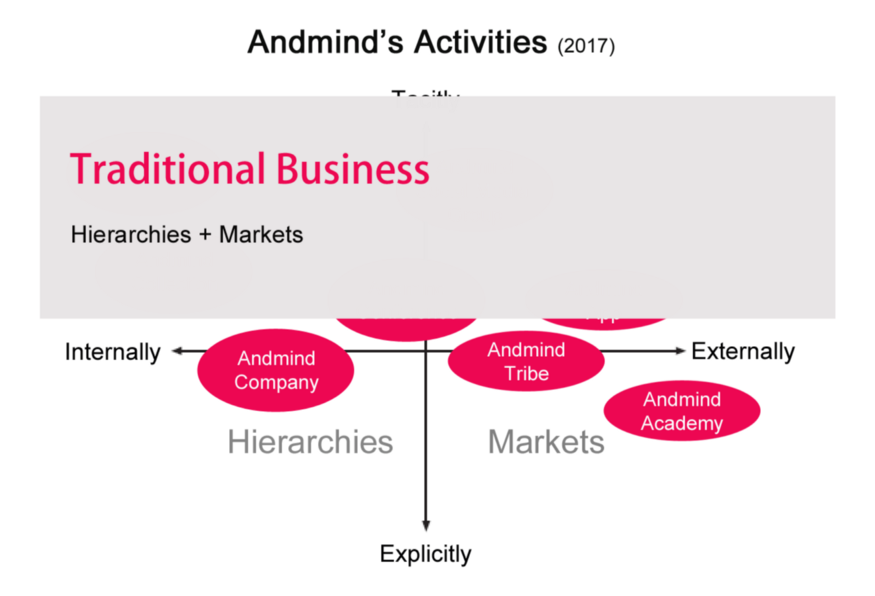
If we combine Hierarchies and Markets, we meet a familiar animal: Traditional Business. The difference between Technological Platform and Traditional Business is if we leverage the power of the Internet to drive growth. From the perspective of business models, some authors called traditional business models as pipelines.
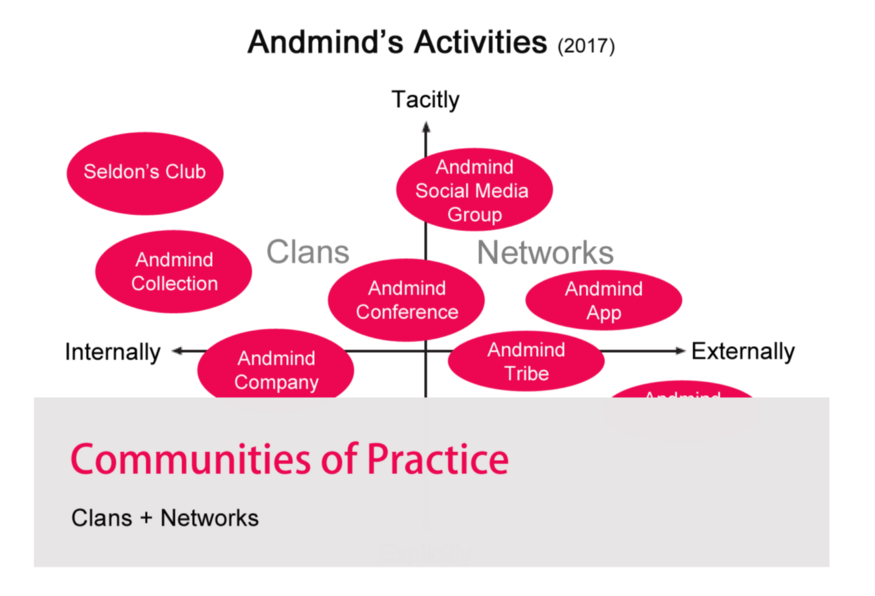
One of the unique aspect of Andmind Group is knowledge-centered content and activities. Many participants use “Andmind Community” to describe the enterprise. If we remove Hierarchies and Markets, we get what Wenger called “Communities of Practice”. Here we see a contradiction between business and non-business.
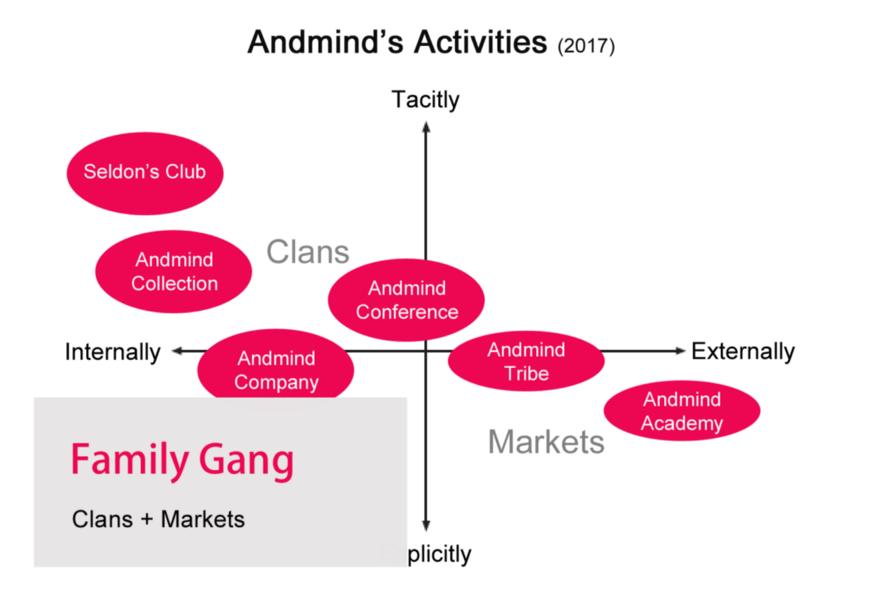
The fifth direction is a hybrid of Clans and Markets. I used “Family Gang” to name this type. It refers to a high efficient “family” kind of private business.
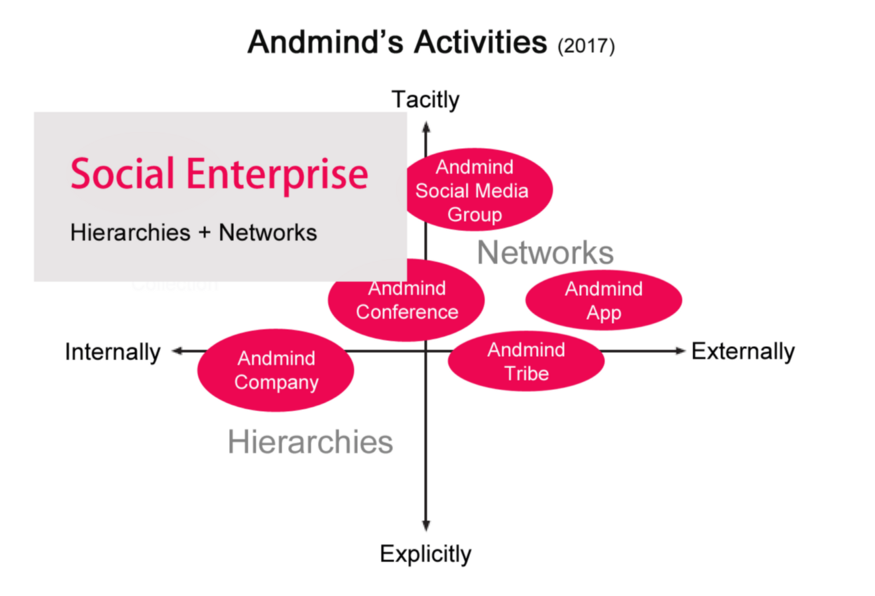
The last one is Social Enterprise. For example, we could consider Andmind Group as another Edge.org which was found by John Brockman.
If we put these six types with Spinuzzi’s original four types, we found there are ten ideal types of activities. Unlike traditional business strategy matrices, Spinuzzi’s matrix focuses on the object of activity and the contradiction between multiple subjects. The case of Andmind Group tells us that the usefulness of the typology is super powerful.
